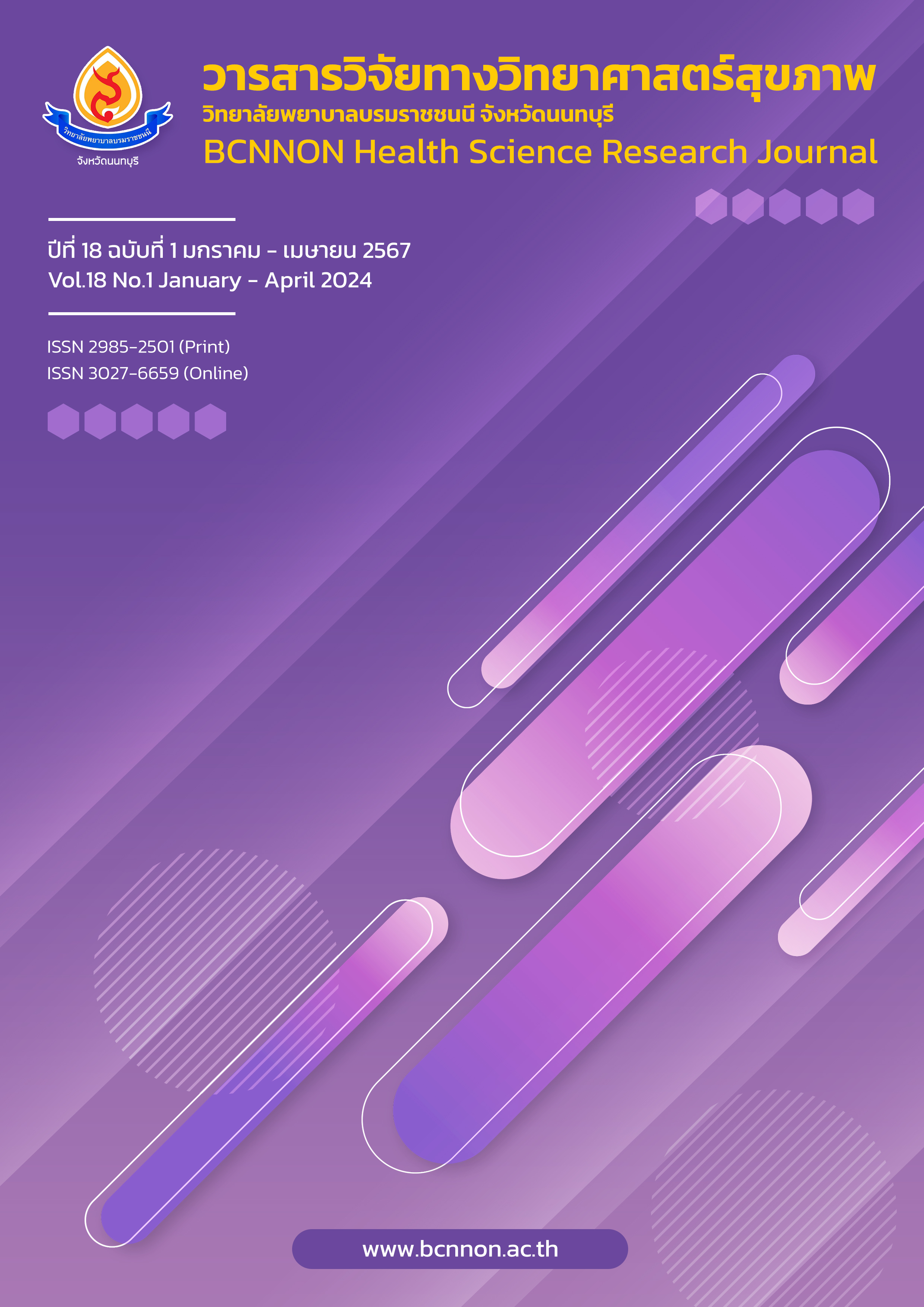ผลของการพัฒนาศักยภาพอาสาสมัครสาธารณสุขประจำหมู่บ้าน ในการป้องกันการฆ่าตัวตายโดยโปรแกรมการเรียนรู้แบบมีส่วนร่วม
Main Article Content
บทคัดย่อ
บทนำ : การฆ่าตัวตายเป็นปัญหาสำคัญของประเทศไทย ซึ่งเป็นการสูญเสียและเกิดผลกระทบหลายมิติกับญาติหรือบุคคลในครอบครัว อาสาสมัครสาธารณสุขประจำหมู่บ้าน (อสม.) ที่เป็นแกนหลักในชุมชนสามารถช่วยป้องกันปัญหาการฆ่าตัวตายได้หากมีการช่วยเหลือที่ทันท่วงที
วัตถุประสงค์การวิจัย : เพื่อศึกษาผลของการพัฒนาศักยภาพ อสม. ในการป้องกันการฆ่าตัวตายด้วยโปรแกรมการเรียนรู้แบบมีส่วนร่วม
วิธีการวิจัย : เป็นวิจัยกึ่งทดลอง แบบสองกลุ่มวัดก่อนและหลังการทดลอง ตัวอย่างเป็น อสม. จำนวน 60 คน คัดเลือกแบบเฉพาะเจาะจงตามคุณสมบัติที่กำหนด สุ่มเข้ากลุ่มทดลอง 30 คน และกลุ่มควบคุม 30 คน ทำการศึกษาระหว่างเดือนมีนาคม ถึง พฤษภาคม 2566 เครื่องมือวิจัยคือ โปรแกรมการเรียนรู้แบบมีส่วนร่วมของ อสม. แบบทดสอบความรู้เกี่ยวกับการฆ่าตัวตาย แบบสอบถามทักษะการดูแลผู้มีพฤติกรรมฆ่าตัวตาย วิเคราะห์ข้อมูลโดยสถิติเชิงพรรณได้แก่ การแจกแจงความถี่ ร้อยละ ค่าเฉลี่ย ส่วนเบี่ยงเบนมาตรฐาน และสถิติทดสอบที
ผลการวิจัย : กลุ่มทดลองมีระดับความรู้และทักษะการดูแลผู้มีพฤติกรรมฆ่าตัวตายหลังได้รับโปรแกรมสูงกว่าก่อนการทดลองอย่างมีนัยสำคัญทางสถิติที่ระดับ .01 และสูงกว่ากลุ่มควบคุมอย่างมีนัยสำคัญทางสถิติที่ระดับ .01
สรุปผล : งานวิจัยนี้ชี้ให้เห็นว่าโปรแกรมการเรียนรู้แบบมีส่วนร่วมช่วยพัฒนาศักยภาพอาสาสมัครสาธารณสุขประจำหมู่บ้านในการป้องกันการฆ่าตัวตาย และควรศึกษาต่อเนื่องเพื่อติดตามผู้ป่วย
Downloads
Article Details

อนุญาตภายใต้เงื่อนไข Creative Commons Attribution-NonCommercial-NoDerivatives 4.0 International License.
บทความที่ได้รับการตีพิมพ์เป็นลิขสิทธิ์ของวิทยาลัยพยาบาลบรมราชชนนี จังหวัดนนทบุรี
ข้อความที่ปรากฏในบทความแต่ละเรื่องในวารสารวิชาการเล่มนี้เป็นความคิดเห็นส่วนตัวของผู้เขียนแต่ละท่านไม่เกี่ยวข้องกับวิทยาลัยพยาบาลบรมราชชนนี จังหวัดนนทบุรี และคณาจารย์ท่านอื่น ในวิทยาลัยฯ แต่อย่างใด ความรับผิดชอบองค์ประกอบทั้งหมดของบทความแต่ละเรื่องเป็นของผู้เขียนแต่ละท่าน หากมีความผิดพลาดใด ๆ ผู้เขียนแต่ละท่านจะรับผิดชอบบทความของตนเองแต่ผู้เดียว
เอกสารอ้างอิง
World Health Organization. Suicide worldwide in 2019: Global health estimates. [internet]. 2021 [cited 2022 Apr 20]; Available from: https://apps.who.int/iris/bitstream/handle/10665/341728/9789240026643-eng.pdf.
Leesawat C. Epidemiology of suicide in Thailand, 2019 – 2020. Journal of Health Science of Thailand. 2022;31(4):623-37. (in Thai).
Information Division. Report on suicide statistics for the year 2020. [unpublished document]. Nakhon Nayok: Nakhon Nayok Provincial Public Health Office; 2020. (in Thai).
Department of Mental Health and Drug Treatment in Ban Na Hospital, Nakhon Nayok Province. Registration of patients with suicide behavior for the year 2022. [unpublished document]. Nakhon Nayok: Ban Na Hospital; 2022. (in Thai).
Department of Mental Health. Guidelines for elevating suicide prevention measures, 2020-2021. [internet]. 2022 [cited 2023 Aug 28]; Available from: https://dmh-elibrary.org/items/show/276. (in Thai).
Sangsurin P, Chatchawanyangkul U, Pramualcharoenkit C, Srisong N. Handbook of new era volunteers. Bangkok: Agricultural Cooperative Federation of Thailand; 2011. (in Thai).
Sakulphan S. Nursing care of people with suicidal behavior. Chiang Mai: Faculty of Nursing Chiang Mai University; 2021. (in Thai).
Khaemmanee T. Teaching science: body of knowledge for effective learning process. 12th ed. Bangkok: Chulalongkorn University; 2010. (in Thai).
Chiangpiew N, Boonchien W, Aungwattan S. Effects of participatory learning regarding stroke prevention on knowledge and self-efficacy among village health volunteers. Nursing Journal. 2018;45(1):87-99. (in Thai).
Petmaneechote K, Pongpumma L, Arunkeeree A, Taowalanon P. Effectiveness of participatory learning program on knowledge and practice of village health volunteers for taking care of hypertension patients. Nursing Journal of the Ministry of Public Health. 2021;31(3):28-41. (in Thai).
Kolb DA. Experiential learning: experience as the source of learning and development. 2nd ed. Hoboken, NJ: Pearson Education; 2015.
Polit DF, Hungler BP. Nursing research principles and methods. 6th ed. Philadelphia, PA: Lippincott Williams & Wilkins; 1999.
Department of Mental Health. Handbook for suicide prevention and care for village health volunteers and community leaders. Nonthaburi: Ministry of Public Health; 2020. (in Thai).
Sanprasan P, Wattradul D, Jamsomboon K, Puapairoj V, Techangkul L, Yuyuen Y. Effects of health volunteer’s capacity building based on participating learning program on knowledge and skill of caring patients with cardiovascular disease and a risk group of cardiovascular disease. Thai Journal of Cardio-Thoracic Nursing. 2015;26(1):119-32. (in Thai).


